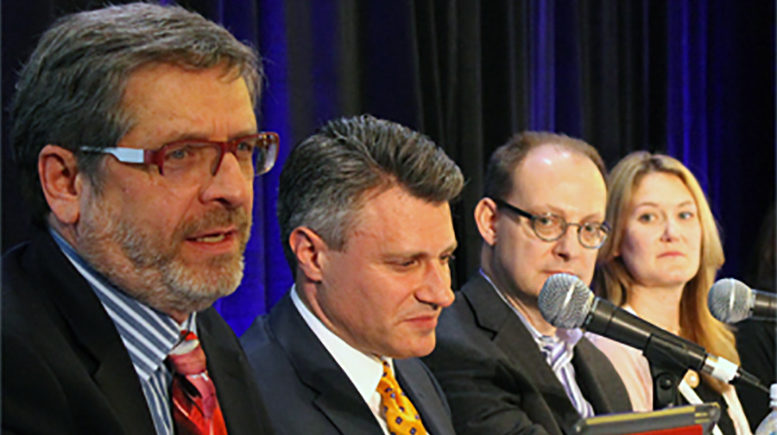NEWPORT BEACH, Calif. — The most innovative ideas and initiatives in workforce education are being developed by partnerships involving community colleges, industry groups, foundations and nonprofits.
Key players in some of these efforts described their work at a plenary session during the American Association of Community Colleges’ (AACC) Workforce Development Institute.
“You have to prepare the partners for the partnership. It doesn’t happen automatically,” said Ivan Charner, director of the National Institute for Work and Learning, a component of the FHI 360 program.
You also need a “theory of change,” and you need to understand inputs and outcomes to guide implementation, Charner said.
Data and evidence are critical, not only for workers and students, but also for other businesses, volunteers and the community. Cultural competence is important, too, he said, as well as knowledge of the business.
Credentials count
It’s important to recognize that many of the themes under discussion – such as workplace learning and employer engagement – are similar, said Jobs for the Future President Maria Flynn. What needs to happen is to move beyond discussions and take it to the next level, she said.
Jobs for the Future is working in California on scaling up a K-12-based initiative to community colleges on a regional level, Flynn said. Establishing student success centers at community colleges is also a key part of this work.
The Association for Career and Technical Education, which mostly serves secondary schools, is encouraging more community colleges to get involved, said Deputy Executive Director Steve DeWitt.
“We’re trying to define what is ‘high quality’ in career and technical education, defining the key components and building a framework around that,” DeWitt said. The organization is looking at articulation and assessment issues and “what is needed on the front end to get to successful outcomes.”
The missing ingredient in getting to student success is improving teacher effectiveness, said Kara Gwaltney, director of evaluations for the College Credit Recommendation Service (CREDIT) at the American Council on Education (ACE).
CREDIT developed 27 modules aimed at helping faculty with instructional design, student engagement and other practices to improve student learning. That led to a broader effort on researching effective pedagogy and how to extend effective teaching practices into workforce programs.
Digital badges
Not every student who takes a workforce training program wants a degree or certificate, Gwaltney said. As a result, ACE is developing digital badges with meta data showing more information than a list of courses completed.
The digital badges will “allow people to take ownership of their abilities,” she said, and they could be embedded in portfolios and social media. “We moved to digital transcripts. This is next.”
ACT is working on an initiative funded by Lumina Foundation to “connect the dots between credentials,” said Mary Lefebvre, senior research scientist for workforce policy. The idea is to help people compare and look at the value of degrees, certificates, “micro-credentials” and other types of credentials.
ACT is also working on other partnerships with several states on a data matching project. “If you can show increased employment, wage gains and retention, it’s a great story,” Lefebvre said. “When you connect that to individual successes, it creates a more powerful story.”
At the Aspen Institute’s UpSkill America initiative, the focus is on working with employers, so employees can advance. “Our mission is to recognize employers who invest in the skills of workers, adopt successful practices and support regional partnerships,” said Director Jamie Fall.
UpSkill America would like to get employers more closely connected with community colleges, Fall said. Employers are investing $1.1 trillion a year on the training and development of workers. They are investing in apprenticeships, certification programs, pre-employment programs and tuition assistance.
“We can’t say all is well,” Fall said. “A lot of the money doesn’t go to the people who need it most.” Much of it goes to higher-level executives. And when it comes to tuition assistance, many employers don’t promote that benefit, they require students to pay first and ask for a reimbursement and they don’t track who is taking advantage of it.
Employer engagement
The nation needs to fill 2 million jobs to replace retirees by 2015, said Brent Weil, senior vice president of the Manufacturing Institute, a nonprofit affiliated with the National Association of Manufacturers.
That requires “a quantum change in the way we operate,” Weil said, noting that “50 percent of manufacturers don’t view community colleges as an effective source of front-line workers.”
“We are helping to lower the barrier of entry and thinking of new ways and approaches for community colleges to work with manufacturers,” Weil said.
He highlighted some of the ways the Manufacturing Institute is working to get manufacturers more engaged. One small effort that is paying off is Manufacturing Day, when companies open their doors to community and technical colleges, he said. Another idea is to have companies identify an ambassador to reach out to community colleges.
The institute is starting a major effort to look at outcomes in career and technical education by pulling together credit-bearing programs and industry certification information and marrying that with wage and employment data to determine what is effective.
“Workforce boards are inextricably linked with education,” said Ron Painter, CEO of the National Association of Workforce Boards. “We have to look at speed and agility. A company that made something three months ago is no longer doing that. We can’t just stand on the sidelines as robotics takes over.”
Painter urged colleges to promote lifelong learning and the need to upgrade skills. “We have to move beyond the silos.”

